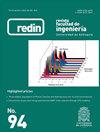由丝素蛋白和羟基磷灰石纳米棒组成的可注射骨替代物的降解、吸水、注射性和机械强度
IF 0.5
Q3 ENGINEERING, MULTIDISCIPLINARY
Revista Facultad De Ingenieria-universidad De Antioquia
Pub Date : 2018-05-05
DOI:10.19053/01211129.V27.N48.2018.8072
引用次数: 6
摘要
可注射骨替代物通常是能够通过装置挤出的复合材料;它们由基质内的固相组成,使粒子易于移动。可注射骨替代物的优点是允许其原位应用而不需要侵入性手术技术,保证了良好的恢复;因此,它们是一种很有希望的替代传统技术来修复骨缺损的方法。传统的技术包括使用同种异体移植和自体移植,这往往会引起不良反应,对病人和医生都不利。此外,在哥伦比亚没有关于骨替代物发展的报告,因此有必要研究可以成为可注射骨替代物的复合材料。在这项研究中,我们用羟基磷灰石和磷酸钙制备了与骨组织最相似的可注射骨替代物,并将它们合成成纳米棒,其形状和大小与体内天然羟基磷灰石相似。此外,我们还使用了从家蚕蚕茧中提取的丝素蛋白,这是一种具有高机械性能和良好生物相容性的天然蛋白质高分子。对于所制造的材料,我们评估了在正常体温下模拟体液(SBF)中的降解,吸水率,注射性和机械强度。制备的骨替代物具有良好的降解和吸水性能,可注射性约为97%,机械阻力低,表明有希望用作可注射性骨替代物。本文章由计算机程序翻译,如有差异,请以英文原文为准。
Degradation, water uptake, injectability and mechanical strength of injectable bone substitutes composed of silk fibroin and hydroxyapatite nanorods
Injectable bone substitutes are generally composite materials capable of being extruded through a device; they consist of a solid phase inside a matrix that allows the easy movement of particles. Injectable bone substitutes have the advantage of allowing its application in situ without the need of invasive surgical techniques, guaranteeing a good recovery; for this reason, they are a promising alternative to replace conventional techniques to repair bone defects. Conventional techniques include the use of allografts and autografts, which often cause adverse reactions, and are disadvantageous for both the patient and the doctor. Furthermore, there are no reports regarding bone substitute development in Colombia, creating the necessity to research composite materials that could become injectable bone substitutes. In this study, we manufactured injectable bone substitutes with hydroxyapatite and calcium phosphate, which is most similar to bone tissue, and synthesized them in nanorods with shape and size similar to the natural hydroxyapatite found inside the body. Additionally, we used extracted silk fibroin from silkworm cocoons of Bombyx mori , a natural polymer of protein nature with high mechanical properties and excellent biocompatibility. For the materials manufactured, we evaluated degradation, in a simulated body fluid (SBF) at normal body temperature, water uptake, injectability and mechanical strength. The manufactured bone substitutes showed good degradation and water uptake properties, an approximate 97% injectability, and low mechanical resistance, indicating promising properties to be used as an injectable bone substitute.
求助全文
通过发布文献求助,成功后即可免费获取论文全文。
去求助
来源期刊
CiteScore
2.00
自引率
0.00%
发文量
27
审稿时长
2 months
期刊介绍:
Revista Facultad de Ingenieria started in 1984 and is a publication of the School of Engineering at the University of Antioquia.
The main objective of the journal is to promote and stimulate the publishing of national and international scientific research results. The journal publishes original articles, resulting from scientific research, experimental and or simulation studies in engineering sciences, technology, and similar disciplines (Electronics, Telecommunications, Bioengineering, Biotechnology, Electrical, Computer Science, Mechanical, Chemical, Environmental, Materials, Sanitary, Civil and Industrial Engineering).
In exceptional cases, the journal will publish insightful articles related to current important subjects, or revision articles representing a significant contribution to the contextualization of the state of the art in a known relevant topic. Case reports will only be published when those cases are related to studies in which the validity of a methodology is being proven for the first time, or when a significant contribution to the knowledge of an unexplored system can be proven.
All published articles have undergone a peer review process, carried out by experts recognized for their knowledge and contributions to the relevant field.
To adapt the Journal to international standards and to promote the visibility of the published articles; and therefore, to have a greater impact in the global academic community, after November 1st 2013, the journal will accept only manuscripts written in English for reviewing and publication.
Revista Facultad de Ingeniería –redin is entirely financed by University of Antioquia
Since 2015, every article accepted for publication in the journal is assigned a DOI number.

 求助内容:
求助内容: 应助结果提醒方式:
应助结果提醒方式:


